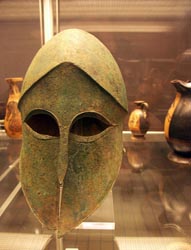Artificial ageing of copper artefacts
Bronze archaeological artefacts represent the development of many civilisations from a period around 3000 to 1000 BC. From China to Babylonia through to the Aegean, the Bronze Age reflects the cultures in terms of tools, art and architecture and the degree of their civilization. Copper-based artefacts develop a patina or an external layer of corrosion products over time in air, water and soil - indeed anywhere these valuable pieces are deposited. The challenge for museums is overwhelming as they must attempt to continue to protect restored pieces from the rigours of our atmosphere. Also, the artefacts may be contaminated with soluble salts such as chlorides so the piece will continue to erode unless treated. Researchers from the European project EFESTUS have developed new methods to restore and conserve these precious artefacts. The project team at the National Technical University of Athens devised a means by which copper alloys can be artificially aged. This was through a combination of chemical and burial treatments of materials similar to those used in the appropriate historic time. The idea was that the degraded copper could then be used as material for trial of the newly developed restoration methods. The whole procedure was devised on the basis of their in depth study of the corrosion process. This involves the formation of an outer layer of copper (II) compounds and an inner layer of the copper mineral cuprite. A layer of copper chloride develops under the cuprite. One of the chemical culprits that speeds up this process is the layer of cuprite. This is thought to allow the transport of chloride and oxide ions inwards. Unfortunately, the chloride ions then act as a so-called autocatalyst. This means they speed up the reaction that they are involved in and furthermore, are one of the products. The result of this reaction then, is that more chloride ions accumulate together with copper chloride as well as cuprite. Research of this nature can benefit the financial health of museums. Continuous restoration and maintenance of artefacts is expensive. Novel methods could help to prevent the corrosion in the first place. The money saved could then be allocated for the installation of environmentally controlled cabinets to control this damaging process.



